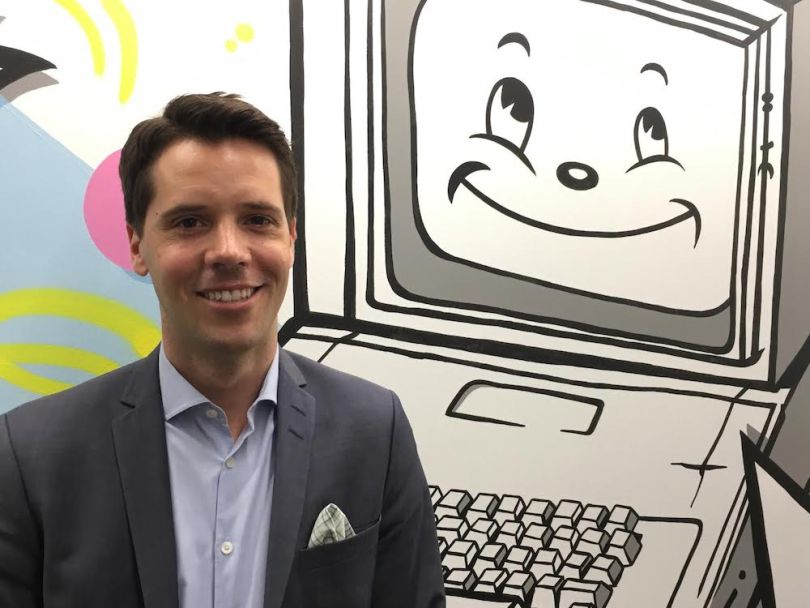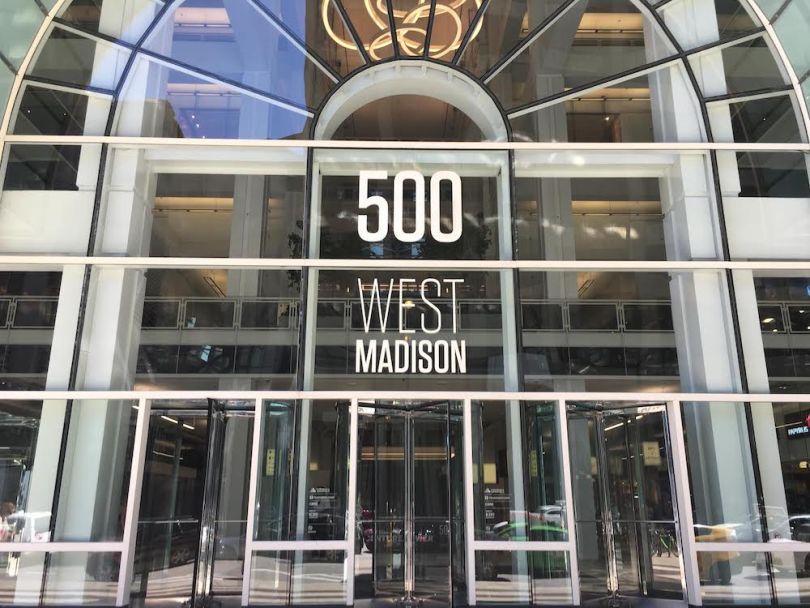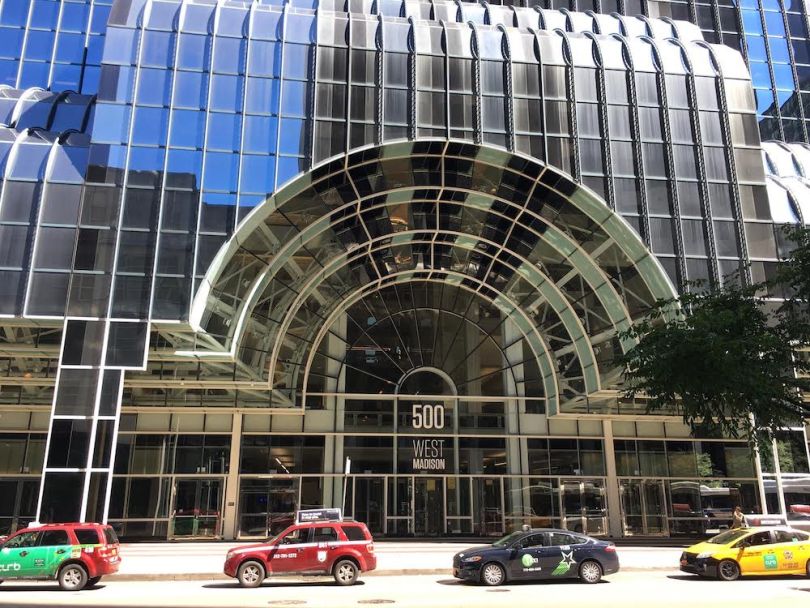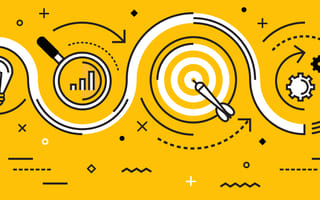Accenture product manager Erik Widman is seated nearby in the very same common area where, just days prior, the governor of Illinois and the mayor of Chicago joined corporate brass to announce 600 new jobs at the professional-services powerhouse’s downtown Chicago office. The press conference backdrop has yet to be packed away, but the dozen or so employees buzzing around the space have clearly moved past high-wattage media events and are focused squarely on the day’s business.
That’s definitely true for Widman, who has no time to slow down. He heads up one of the company's roughly two dozen so-called Liquid Studios, each of which he likens to an in-house “mini startup." They focus mostly on proof-of-concept products, all involving AI, computer vision, augmented reality, IoT or other bleeding-edge technologies.
His work duties split pretty evenly between administrative and creative tasks. Widman generally spends half his time planning and leading meetings, interviewing an influx of job candidates spurred by the recent hiring spree and handling other administrative upkeep. Don't feel too bad for him, though. The flip side — highly creative work that's performed speedily and with a large degree of autonomy — is more than a bit enviable.
What Does a Product Manager Do?
What happens at a Liquid Studio?

Moving at a quick clip, the Liquid Studio team uses rapid ideation and prototyping techniques to build out a product in just six to eight weeks. Rather than polishing products to a flawless shine, however, Widman's crew is charged with the swift demonstration of what’s possible.
If a client wants to expand the team's built-out model into a commercial enterprise version, Accenture accommodates by transitioning the product to a delivery team, and Widman remains available to guide the transition as needed.
Accenture's Chicago lab focuses on the Midwest market, which means a lot of logistics-based product development, but also financial services, insurance, telecommunications and some agriculture, among other industries. Information about specific clients is hard to come by, but there's lots of work involving speech-based artificial intelligence — or as Widman describes it, "conversational voice AI."
"Think Alexa skills or Google Assistant actions," he says. "That's one of our main focus areas right now, and we've done a lot of that work in the past."
Clients, he adds, include a lot of Fortune 100 companies. And while he's necessarily tight-lipped about specific work done for them, "it's products that you've probably used or seen.”
Things that roughly fall into three broad categories: jobs commissioned by outside clients; internal demonstration products that Accenture can then market to prospective customers; and “social innovators” — products designed to ameliorate intractable social issues, like climate change. Widman's current projects include one internal demo and another that's social-focused.
The role's steep technical learning curve and accelerated tempo suits Widman. As a young man from Sweden who trained in electrical engineering, he originally set out to build guitar amplifiers and other music equipment. (A former full-time musician, he still records and performs.) But the music-gear route wasn’t challenging enough, so he eventually gravitated to biomedical engineering, making devices like pacemakers and ultrasound imaging algorithms. Still, he found that industry slow and change-resistant, and pined for something more nimble. That's when ultra-high-tech product management entered the picture.
From Concept to Reality

Nimble or not, all big-idea projects require lots of focus on granular details, which means early-week prep. In light of that, a Monday-in-the-life of a product manager at Accenture’s Liquid Studio is a bit like the vegetables that precede dessert. In order to set the weekly cadence, Erik holds sprint plannings with his team and boss to pinpoint priorities and devise a targeted plan for the days ahead. (Side note: Product managers must know how to speak fluent Agile.)
Much of the day's second half involves reporting to internal shareholders.
“We go over what we're doing, how things are going, what problems we're having and what we need help with,” Widman says.
It’s by far the most administrative-heavy day of the week, and it leaves Widman with only about an hour or two for creative work.
“That day’s a bit of an anomaly," he says. "But it is what it is. You have to do it.”
Soon enough, though, milestone-setting and status-reporting give way to the fun stuff. A given Tuesday, for example, might include working on wireframes, writing up user stories, or getting "guerilla-style" feedback from users on a certain product's newly redesigned features.
The same cafe/common space in which Widman and I first meet also serves as an impromptu research laboratory where he wrangles test subjects. Regardless of whether they're internal or external, he says, they’re generally helpful when approached for input.
"People are always very friendly and happy to try things out and excited to see something new.”


Of course, the exact nature of a day’s tasks depends on a product's life cycle status. Widman winkingly invokes the old product management saw that no two days are the same — a sentiment that happens to be true, particularly in his accelerated realm.
“Maybe one's kind of wrapping up and getting into the marketing and selling phase, and another one's kicking off, so you go back to the creative phase and ideation,” Widman says. “You're jumping between the worlds a little bit … Some people find that really challenging; to me, that's more fun.”
Despite its fluctuations, the process follows a basic routine. First, Widman works on creating a product vision, doing research (online and via direct user interviews) to identify specific problems that need addressing and create a roadmap. "I typically think about the jobs to be done to solve the problems, and what specific features would solve the jobs," he says. "From there, I break the features down into smaller pieces of work and write user stories for them." Throughout the process, Widman keeps stakeholders up to speed and makes sure that what he's assembling meets their needs.
“What I've found is that product managers need to have a lot of different skills because you never have all the resources you need,” Widman says. “So I'm often involved in everything from wireframing to doing actual design work, because I don't always have the luxury of having a designer. And then writing user stories about different features, communicating that to your development team, doing all the traditional scrum ceremonies to make sure that everyone understands what we're building.”
Few people have access to all the professional resources they need, or think they need, and product managers are no different. The workaround? Make yourself as well-rounded as possible.
“You have to learn how to do a little bit of everything: design, how to code, a little bit about systems architecture, product strategy, all the traditional product management tools," Widman says. "I've always been of the philosophy that the more you know, the more skills you have, the more valuable you are."
Finally, there’s post-production. Widman spearheaded the development of an app that's about to hit this phase, which means it’s time to look for internal and external marketing help, run everything through legal and exterminate any lingering bugs — all of which he has a hand in.
“It really is like a startup, where you own the product,” he says.
And if the build is similar to that of a startup, then he’s effectively the CEO whose job it is to make sure every detail is covered: “I created a product, now I have to sell a product.”
This Janus-like coexistence of artistic vision and linear logic is fairly rare.
“I've found that's kind of a unique skill,” Widman says. “Most people are either creative but don't have the technical chops, or they’re technical and fairly linear but don't have that nonlinear thinking. My sweet spot is being able to jump between those two types of thinking.”
An Innovative Product

Widman is currently wrapping up a product that falls into the so-called social innovation bucket, as opposed to an external client solicitation or an internal demo. An augmented-reality mobile app, it translates users’ daily commute emissions into a more universally comprehensible metric: how many trees it would take to counterbalance a year's worth of those commutes. The app then recommends actions users can take to offset their pollution. Developed as part of an in-house tech challenge, it will be made public in partnership with a green nonprofit later this year.
The app’s AR garnishes are indeed attractive. Vaguely otherworldly, even.
“That's always been a goal of mine, trying to make technology not feel like technology, but just make it feel magical,” Widman says.
Digital, cartoon-like augmented-reality trees start to populate video of a real green space after the user inputs commute details. In the demo Widman showed, there’s even a random real-life figure wielding a metal detector who just happened to be around when the park scene was filmed. Whether he survives past the beta stage remains to be seen, but it’s a fun bit of verisimilitude — and perhaps something of a metaphor for the hard-to-anticipate challenges lurking in the distance when it comes to emerging-technology product development.
But the app’s substance — its protein, to toss in another food metaphor — is the actionable information it provides.
“Everybody can understand trees and everybody cares about trees, right? That's the real innovative part,” Widman says. “And then we're using augmented reality to make a fun experience, kind of like a cherry on top. It’s important to combine fun with education to make enjoyable products.”
The emissions app and those like it — products with a social rather than a commercial focus — are essentially passion projects. They stack on top of all the standard must-do assignments rather than bumping them aside. That means a lot of off-hours and off-premises labor.
Widman conducted his “guerrilla” UX interviews for the app during multiple Saturdays at a Logan Square coffee shop. In fact, that’s standard operating procedure regardless of a product’s application.
“Every week we try to have a build ready on Fridays,” he says. “Then I can go out and play with it on the weekend. It doesn’t feel like work.”
That sense of discovery stretches across technologies. Even in a post-Ingress, post-Alexa landscape, the path of building an AR or AI product — or any other emerging-tech offering — is hardly well-trod terrain.
"Everything's super ambiguous and very cloudy," Widman says.
The product manager has to ask: What platform makes the most sense? What channel? In the instance of a chatbot, say, which intents (a.k.a., the intentions of the user) will be handled?
"There’s a lot of ambiguity — across the board."
Wading through that murk to ultimately produce a cutting-edge product requires many hours of preparation, research, user outreach, testing and, yes, a fair amount of administrative tedium. For Widman, though, it's the ideal gig.
"I love seeing people light up when they try a product that I've worked on, when it teaches them something new, or when something unexpected happens that delights them," he says. "Those moments of magic make all the hard work worth it."
Photos by Stephen Gossett; illustration via Shutterstock




